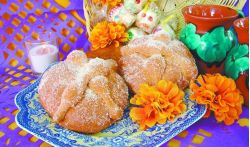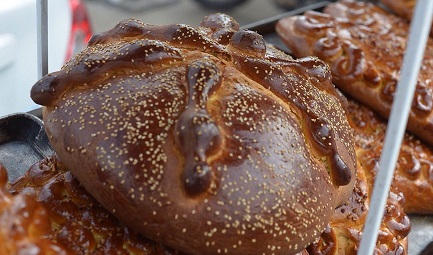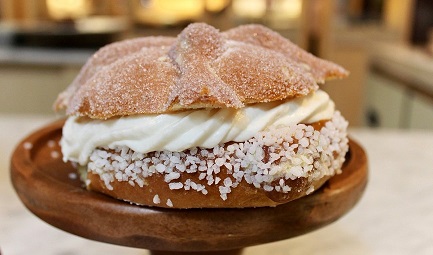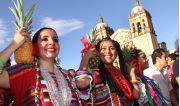One fiesta bread

Like the Slavs who cook Easter Kuliches once a year, the Mexicans have a special bread dedicated to one of the most ancient and most respected holidays – the Day of the Dead. It is called "bread of the dead" (“Pan de muerto” in Spanish), and you can try it throughout October and on the first week of November.
The bread of the dead always occupies a central place on the altars organized in every house and even official institutions on the eve of November 2. During October, this pastry is sold in supermarkets and private bakeries, and in the villages many housewives still bake it themselves using family recipes.
The most common variant of the bread oh the dead is a pastry based on milk or water with a side of anise, vanilla, and orange peel. The baked bread is sprinkled with sugar. Some bakeries sale the bread of the dead with a filling, which is added after baking. It can be sweet cottage cheese, boiled condensed milk, custard (even based on tequila or pulque, for example).



Usually the bread of the dead looks like a round loaf with the stripes of dough placed on top, in the form of rays diverging from the center, and a ball of dough is usually placed in the point of their intersection. But the look of this bread depends on the region, and in some states of Mexico it is baked in the form of a cross, heart and even a skull. How did this kind of baking come about? What does it symbolize?
The origin of the bread of the dead goes back to the pre-Hispanic period, even then it was prepared for the altars – only not of wheat flour, but of grinded toasted amaranth seeds, still widely used by Mexicans in their diet. It is believed that the ancient bread was poured by the blood of people sacrificed to the gods. Also, a ritual of princess sacrifice is talk about: her heart was torn from her chest and, still beating, was lowered into a container with amaranth seeds, and after that the high priest had to bite warm flesh. After the arrival of the Spaniards such rituals were refused and the bread was started to make from wheat in the form of heart, sprinkled with sugar and red powder.
The decorative elements of the bread of the dead are not accidental. It has a round shape, because the circle symbolizes the life cycle. The dough ball located on the top of the loaf is associated with the skull – it is not only an attribute of death, but also a symbol of wisdom, connection with the ancestors. The rays of the dough, diverging from the "skull" (they are usually four) are bones, and they are arranged in the form of a cross to indicate a connection with the four elements, each of which is dedicated to a definite god - Tezcatlipoca, Tlaloc, Quetzalcoatl and Xipe-Totec. And a bright taste of the bread (thanks to an orange, as a rule) reminds us of deceased.
For today there are dozens of recipes for the bread of the dead, almost every state prepares it in its own way. For example, in Michoacan, such bread dough is kneaded with some plants juice, which gives a brown color to the baked product. In Puebla, the bread is sprinkled with sesame or red sugar before baking, and in Oaxaca it is even made of puff pastry.

Guelaguetza is the most important festival in the Mexican state of Oaxaca. The representatives of the eight regions of the state – Cañada, Costa, Istmo, Mixtec, Papaloapan, Sierra Sur, Sierra Norte and Valles Centrales – gather on the hill Fortin for the most colorful dance festival of the country.

Mexico and its folklore, Mexico and its people, Mexico and its kitchen, Mexico and its culture... It’s true, this country has a lot. Foreigners who once have visited it fall in love with its peculiarities and even strangeness. Do you want to know more about them?















